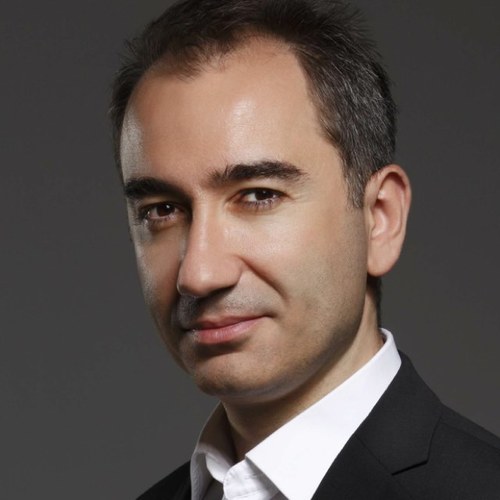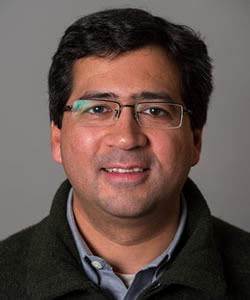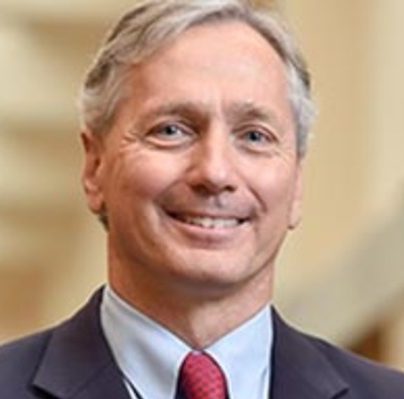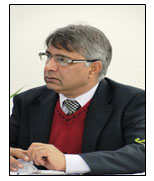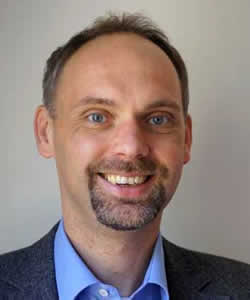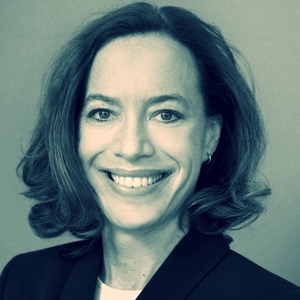A recent search of the term “burqa” on CartoonStock.com turned up a plethora of images of women in black and blue veils. In one image a black-clad woman in a delivery room gives birth to a tiny, similarly garbed miniature, as a nurse proclaims, “It’s a girl!” In another, a woman in a black niqab, with only her eyes exposed, sits in front of a computer featuring the webpage “Hidden Facebook.” In yet another, a close replica of the angst-ridden figure in the Norwegian artist Edvard Munch’s famous painting “The Scream,” stands before a minaret and a woman in a blue burqa symbolizing Europe’s horror at the specter of Islamic symbols in its midst. The black and blue images call to mind the big red blob—creeping Communism, of course—that terrorized American moviegoers in the 1950s.
“Burqa Chic” in Chicago
In a clothing boutique in Chicago’s famed shopping mecca, Water Tower Place, I was recently approached by a woman in a black headscarf and body-covering cloak, her face exposed and offset by rimless eyeglasses, one of the boutique’s signature mohair scarves in a bright and plummy shade draped around her shoulders and over the veil. She asked if I needed assistance. I thanked her and replied that I was just looking. As I left the boutique to run a few errands, something about her seemed familiar. Sometime during the next hour or so I remembered. More than the face, it was her voice that cinched the realization. I returned to the store, approached the saleswoman, and addressed her by name.
It turned out that this saleswoman, of South Asian origins, had previously represented the clothing line at a nearby department store, before going to work for the company for several years in New York, and then returning to Chicago. She mentioned that not all of her previous customers recognized her “with the veil.” I was intensely curious about the veil, but as a stalwart for privacy in world in which privacy—including privacy in faith, where desirable—is increasingly an antique notion, I demurred. Even as the American public has embraced the practice of demanding faith statements from its political leaders, it occurred to me that this woman’s religion was really none of my business.
Secularism and Dissimulation
On April 11, 2011, the controversial 2010 “Burqa Ban” law, officially the Bill Against Facial Dissimulation in Public Places took effect in France, banning face-covering veils—the burqa and niqab, but not the hijab or headscarf—in all public places. Even as someone who studies law and religion, this issue—dating back to France’s 2004 Law on the Principle of secularism and the Wearing of Symbols or Clothing Denoting Religious Affiliation in Schools, Colleges and High Schools or even back to France’s 1905 Law on the Separation of Church and State or the French Revolution for the historically minded—just never grabbed me. As a feminist concerned about the hypersexualization of women’s bodies in our culture, I was more likely to be concerned about women taking off their clothes, not covering up. And what was with the constant scrutiny of what women wear anyway? It all reeked of that pernicious “women-in-miniskirts-deserve-to get-raped” mentality. As a child of the 1980s “preppy” era, I remembered, from a fashion perspective, when “status” meant piling on as many clothing layers as possible, a practice which spawned many interesting innovations and embellishments to the uniforms in my Catholic girls’ school, even in hot and humid southern Louisiana. I was the first to get away with a black leather biker’s jacket, soon followed by others who, like me, interpreted the meaning of the school’s “Rebel Girl” mascot a bit too literally.
But as the rhetoric rose, I pricked up my ears. In January 2010, the French National Assembly considered a 188-page report on the wearing of the “voile intégrale” as a threat to the French republican values of “liberty, equality, and fraternity” and, above all, as a challenge to the French program of secularism known as “laïcité.” With the several hundred pages of accompanying testimony transcripts and other appendices, the documentary behemoth comes in at 658 pages. Printed and bound, it resembles one of those volumes of the United States tax code that some American politicians like to trot out in the halls of Congress every April 15. But the French law that went into effect this April 11 apparently won’t deplete anyone’s bank account, unless you count the salaries to be paid to instructors in the “special classes” that French women will be required to attend, along with paying a fine, if they are caught publicly en voile. In a down academic job market for instructors in religion, ethics, and political theories of citizenship, teaching those classes could be a pretty good employment gig.
At Once Ancient and Modern
The lengthy first section of the French’s parliament’s report takes pains to note that the wearing of the veil is, at once, of “ancient origin” and a “recent development.” Like many such arguments, and with a commitment to originalist interpretation that United States Supreme Court Justice Antonin Scalia would admire, it emphasizes repeatedly the practice’s lack of a specific textual basis in the Qur’an, aside from general commands of modesty. Even in the face of testimony from women who wear the veil on their motivations for doing so and the meaning of the veil in their lives, the report drafters, in their theological and anthropological wisdom, constantly return to their insistence that the veil is not an “obligatory prescription” in Islam. But whether it was originally obligatory says nothing about its modern meaning. As French historian Joan Wallach Scott has impressively argued, for the women who wear it, the veil may be part of the very essence of being a modern, French, Muslim woman.
Of course, those more “recent” meanings, in a context in which the majority UMP party French President Nicholas Sarkozy last month decided to emulate the New York Congressman Peter King in conducting a national debate on secularism and Islam, are potentially even more problematic. The debate was retitled “Secularism: To Live Better Together” and produced a 26-point “Pacte Républicain” to better instantiate “laïcité” in French politics and society.
The French veil report, which contains way more than 26 points, suggests that the veil is a “rogue sign of a quest for identity” (signe dévoyé d’une quête d’identité) and the “standard of radical, communitauriste movements” (l’étendard des mouvements communitaristes et radicaux”). Among the specific supposed threats to French values, no Western feminist can avoid some amount of concern about liberty and equality, particularly if women are coerced by their families or communities into wearing the veil, which could involve violations of their civil or political rights, or if their wearing of the veil disadvantaged them in education or employment, which would violate their economic, social, and cultural rights—not to mention their religious freedom. But then then state, particularly a state with as grand a mission as suggested in the French veil report, should have the mission and the duty to protect women—and men, too—who wear religious garb from those sorts of human rights violations.
Refusing to Be a Person
Where the French veil report gets really interesting, at least to this reader, is in its assertion that the veil is a threat to “fraternity.” For “fraternity,” it turns out, invokes a number of conceptions of citizenship and civility that the French are concerned to protect. In a May 4, 2010, New York Times editorial provocatively, and rather sexually suggestively, titled “Tearing Away the Veil,” Jean-Francois Copé, majority leader of the National Assembly and mayor of the town of Meaux, where some of the early headscarf cases emerged, maintained that the wearing of the veil represents a “refusal to exist as a person in the eyes of others” and renders the wearer a “shadow among others, lacking individuality, avoiding responsibility.” In Copé’s view, these veiled women are faceless—and possibly threatening—blobs within the French body politic.
The Copé editorial was followed in the Times just over a month later by philosopher Martha Nussbaum’s spirited defense of the veil, inspired by the Spanish rejection of a burqa law and titled, “Veiled Threats?,” which elicited 757 reader comments from around the world, many of them quite incendiary in their opposition to the veil. That article was followed by response by Nussbaum, titled “Beyond the Veil,” which drew an additional 199 responses. Clearly, between the French veil report’s many pages and Nussbaum’s many responders, much ink has been spilled and many electrons transmitted over the veil issue. How had this been under my radar for so long?
“Mirror of the Soul” and the Reciprocity of Recognition
Aside from legitimate security concerns that would require women to submit photos of their faces for identification and passport purposes, could there be so much riding on the presence of a face-obscuring cloth when it comes to citizenship and civility? Just a few weeks before the Copé editorial I had read an article, also in the New York Times, about a condition called Moebius Syndrome—a rare, conditional condition that causes facial paralysis and leaves those afflicted with it unable to form the facial expressions that are so important in social interactions. Another article around that time in the Chronicle of Higher Education described an economic recessionary trend away from conference interviews for academic jobs and toward telephone interviews instead, noting that this could be disadvantageous for candidates who “don’t come across as well to potential employers if they’re not looking them in the eye.” My search for the telephone interview article turned up another article titled, “Why Darwin Would Have Loved Botox” on Darwin’s theories about the evolutionary origins of facial expressions as the “language of emotion.” For their part, the French veil report drafters drew upon French, Jewish philosopher Emmanuel Lévinas’ theory of the face as the “mirror of the soul.”
I find myself somewhat persuaded by these medical, professional, and evolutionary psychological testimonies to the importance of facial expression—but not to the extent of banning the burqa. Perhaps the most compelling concern that I have against the veil involves considerations of reciprocity, a term that does come up in the French discussion of fraternity, and is also crucially linked to justice in the Aristotelian theory from which I draw frequently scholarly sustenance. One could also draw on contemporary German philosopher Jürgen Habermas’ theories of communicative action and intersubjectivity, as well. They can see me, but I can’t see them. More pointedly, in my unveiled and emotion-reflecting state, I make myself vulnerable in a way that they do not. This bugs me.
But what irks me equally and also raises vulnerability concerns—and it is a trope that occurs again and again in the French veil report—is the overwhelming scope of the French public sphere. Reflections on the relationship between public and private are a staple of liberal political thought, and feminist theory has often noted the ways in which women are relegated to—and sometimes trapped—within the private realm. But full publicity is frightening, as well. There is nowhere to run, nowhere to hide, nowhere to escape those aspects of community that seem threatening, including the omniscient and omnipresent State.
My ultimate conclusion that the saleswoman’s reasons for wearing the veil were, in a sense, nobody’s business but her own was a plea for this kind of privacy—and of individuality. My continuing curiosity about those reasons, on the other hand, suggests the demands that recognition of religious identity makes of us in a pluralistic society. Recognition exists in an interesting tension with reciprocity. Does reciprocity demand a certain amount of recognition? Is it possible to recognize—even respect—another’s religion without full reciprocity of belief? These are some of the crucial questions when it comes to religion—and the veil—in a pluralistic and democratic modernity.

